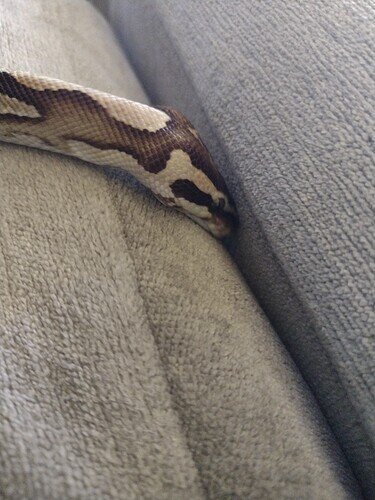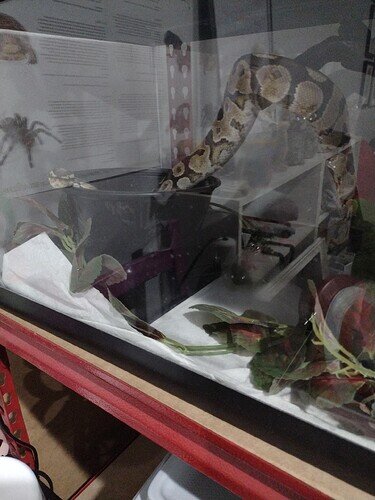First off good morning, and holy cow i didn’t expect so many responses, thank you all!!
@armiyana
Jupiter (problem child) has been fed outside his enclosure in a separate box since… hatchling-hood? He’s never shown any signs of stress while eating, takes basically any warm rodent, and has never regurged in his life (woo!)
I might’ve accidentally ‘trained’ him into thinking hands = food incoming when in his enclosure, but I’m not sure how, since it’s only been done twice. The thing is, he simply will not register that the hook is not food, it’s been three and a half (as of today) months since his last home feeding.
He’s only at 600 grams now, and he’s always been a bit dumb, so maybe he thinks he’s gonna get himself a lady and needs to bulk up 
@banereptiles
I agree as long as it’s not putting the snake (or me) in harm’s way 
Might be the time of year, and the fact it’s raining quite a bit, but his ‘brother’ isn’t acting like that either, and currently sits at 650 grams himself- Granted, I got them right as breeding season ended/hatchling season began, so they’ve never experienced the whole ‘its time to make some babies’ part of the year.
@d_y_python
I feed once a week, a small rat that’s around the width of the chunkiest part of his body, maybe a bit smaller. He’s pretty long instead of thick, almost five inches longer than his 650 ‘brother.’ He takes rats or mice, but I’ve only been feeding rats for the past year or so.
I do feed them all at the same time, but I thaw the rodents inside a bin in a separate room, and he always gets fed first. The two other snakes don’t care at all, so they get fed afterwards.
If he’s been extra naughty (biting at random things), around thirty minutes, but usually only ten or so. When he’s not trying to eat me, he’s a chill dude, and just explores around and scopes everywhere.
And y’all are so polite, ask any questions you want!
@caron
My eldest was super picky for a few months, but I’m proud to say he’s now a Good Boy and eats on a regular schedule!!
@athleticshoelace
I’ll definitely be trying target training, now that I remember it exists  but I’m not sure how effective it could be, since he doesn’t care about tap training. But it sounds like a fun project, and I’ve seen great results, so fingers crossed!
but I’m not sure how effective it could be, since he doesn’t care about tap training. But it sounds like a fun project, and I’ve seen great results, so fingers crossed!
@ballornothing
If Jupiter isn’t already in ‘I will eat you’ mode, I scoop him up immediately. When he’s sassy, I tap his head (which results in him striking towards me roughly one out of four times) and then lift him with a hook; But if his little head is faced towards me, he can and will fling his entire body towards me to try and get a bite. (He’s never fallen off, his enclosure is near the ground because of his spice, and I have carpet, so don’t worry!)
I actually have tried covering him up before, but if anything, it made him angrier. Maybe he thinks because it’s darker, he needs to try harder? Or maybe it’s just because he’s crazy. I tried a cool towel over the side facing me, and that seemed to curb it, but he still struck if he sensed any heat or movement.
I do bop his little head with either paper towel or the hook, but he always jerks up and stares it down no matter how many times I tap him. He is very dumb. Usually i can lift him and handle him for a minute or four and he stops being a spicy jerk.
Well, I might just have to deal with his rage forever, but I thank y’all anyways! I greatly appreciate your suggestions, and will be sure to test them out. Feel free to ask any more questions y’all have! And, as more ‘payment’ for y’all’s help, here’s another stupid picture of the criminal.
No, i did not put his water dish up there. No, i have no idea how he got it there. Yes, he spills it often.
Addition: he was moved to a larger house around seven months back and loves sitting on his branch when not angry at the world.











